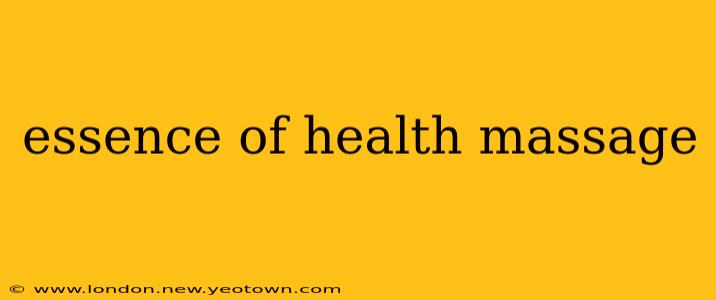Imagine sinking into a plush massage table, the soft music washing over you as skilled hands begin to knead away the tension built up from a long day, a stressful week, or even years of accumulated stress. That's the immediate appeal of massage, but the essence of health massage goes far beyond simple relaxation. It's a holistic practice that deeply impacts your physical, mental, and emotional well-being. It's a journey towards a healthier, more balanced you.
Let's delve into the heart of what makes health massage so effective and explore some of its many benefits.
What are the main benefits of massage therapy?
This is a question often asked by those curious about massage's potential. The answer is multifaceted. Massage therapy offers a range of benefits, depending on the type of massage and the individual's needs. However, some core advantages consistently emerge:
-
Pain Relief: Massage can significantly alleviate muscle pain and stiffness, often stemming from injuries, overuse, or poor posture. The manipulation of soft tissues helps to reduce inflammation and improve circulation, promoting faster healing. Think of it as a deep, targeted reset for your body.
-
Stress Reduction: In our fast-paced world, stress is a pervasive issue. Massage works wonders in combating this, lowering cortisol levels (the stress hormone) and promoting the release of endorphins, natural mood boosters that leave you feeling calmer and more relaxed.
-
Improved Sleep: The combination of reduced stress and pain relief often translates into improved sleep quality. A good night's rest is crucial for overall health, and massage can be a valuable tool in achieving it.
-
Increased Circulation: Massage stimulates blood flow, carrying oxygen and nutrients to muscles and tissues, promoting healing and overall cellular function. This improved circulation also aids in the removal of metabolic waste products.
-
Enhanced Flexibility and Range of Motion: By releasing tight muscles and improving joint mobility, massage contributes to increased flexibility and a greater range of motion. This is particularly beneficial for athletes and individuals with limited mobility.
What are the different types of massage?
The world of massage is diverse, with numerous techniques tailored to specific needs and preferences. Some common types include:
-
Swedish Massage: A gentle, relaxing massage focusing on long, flowing strokes to promote relaxation and relieve muscle tension. This is a great introductory massage for those new to the experience.
-
Deep Tissue Massage: This technique targets deeper layers of muscle and connective tissue to release chronic tension and address specific pain points. It's more intense than Swedish massage and is often used to treat injuries or long-term muscle problems.
-
Sports Massage: Specifically designed to address the needs of athletes, this type of massage helps prevent injuries, improve performance, and accelerate recovery.
-
Hot Stone Massage: Uses heated stones to penetrate deeper into muscle tissue, providing a more intense and therapeutic experience. The warmth of the stones enhances relaxation and promotes deeper muscle relaxation.
How often should I get a massage?
The frequency of massage depends entirely on individual needs and goals. Some people opt for regular maintenance massages once a month, while others may require more frequent sessions to address specific injuries or conditions. Consulting with a massage therapist can help determine the optimal frequency for your unique circumstances.
Is massage therapy safe for everyone?
While generally safe, massage therapy isn't suitable for everyone. Individuals with certain medical conditions, such as deep vein thrombosis or active infections, should consult their physician before undergoing massage. Always inform your massage therapist about any health concerns or medications you are taking.
What should I expect during a massage session?
A typical massage session begins with a consultation to discuss your health history and goals for the treatment. The therapist will then assess your body and tailor the massage to your specific needs. During the session, you will lie comfortably on a massage table, fully or partially clothed, while the therapist uses various techniques to manipulate your soft tissues. Many find the experience deeply relaxing and rejuvenating. Post-massage, you may feel a sense of calmness and relief, along with some temporary soreness (particularly with deep tissue massage).
The essence of health massage is its ability to holistically improve your well-being. It's a powerful tool for pain management, stress reduction, and overall health enhancement. By understanding its diverse benefits and choosing the right type of massage for your needs, you can embark on a journey towards a healthier, more balanced life. Remember to always consult with a qualified professional to determine the best approach for your individual circumstances.

